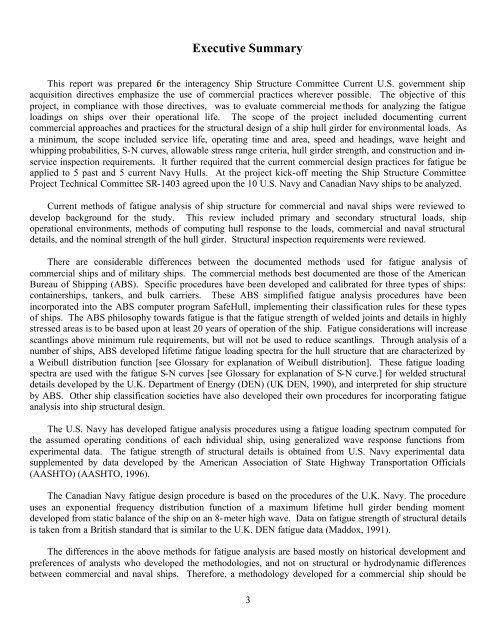ssc - 419 supplemental commercial design guidance for fatigue ship ...
ssc - 419 supplemental commercial design guidance for fatigue ship ...
ssc - 419 supplemental commercial design guidance for fatigue ship ...
You also want an ePaper? Increase the reach of your titles
YUMPU automatically turns print PDFs into web optimized ePapers that Google loves.
Executive SummaryThis report was prepared <strong>for</strong> the interagency Ship Structure Committee Current U.S. government <strong>ship</strong>acquisition directives emphasize the use of <strong>commercial</strong> practices wherever possible. The objective of thisproject, in compliance with those directives, was to evaluate <strong>commercial</strong> methods <strong>for</strong> analyzing the <strong>fatigue</strong>loadings on <strong>ship</strong>s over their operational life. The scope of the project included documenting current<strong>commercial</strong> approaches and practices <strong>for</strong> the structural <strong>design</strong> of a <strong>ship</strong> hull girder <strong>for</strong> environmental loads. Asa minimum, the scope included service life, operating time and area, speed and headings, wave height andwhipping probabilities, S-N curves, allowable stress range criteria, hull girder strength, and construction and inserviceinspection requirements. It further required that the current <strong>commercial</strong> <strong>design</strong> practices <strong>for</strong> <strong>fatigue</strong> beapplied to 5 past and 5 current Navy Hulls. At the project kick-off meeting the Ship Structure CommitteeProject Technical Committee SR-1403 agreed upon the 10 U.S. Navy and Canadian Navy <strong>ship</strong>s to be analyzed.Current methods of <strong>fatigue</strong> analysis of <strong>ship</strong> structure <strong>for</strong> <strong>commercial</strong> and naval <strong>ship</strong>s were reviewed todevelop background <strong>for</strong> the study. This review included primary and secondary structural loads, <strong>ship</strong>operational environments, methods of computing hull response to the loads, <strong>commercial</strong> and naval structuraldetails, and the nominal strength of the hull girder. Structural inspection requirements were reviewed.There are considerable differences between the documented methods used <strong>for</strong> <strong>fatigue</strong> analysis of<strong>commercial</strong> <strong>ship</strong>s and of military <strong>ship</strong>s. The <strong>commercial</strong> methods best documented are those of the AmericanBureau of Shipping (ABS). Specific procedures have been developed and calibrated <strong>for</strong> three types of <strong>ship</strong>s:container<strong>ship</strong>s, tankers, and bulk carriers. These ABS simplified <strong>fatigue</strong> analysis procedures have beenincorporated into the ABS computer program SafeHull, implementing their classification rules <strong>for</strong> these typesof <strong>ship</strong>s. The ABS philosophy towards <strong>fatigue</strong> is that the <strong>fatigue</strong> strength of welded joints and details in highlystressed areas is to be based upon at least 20 years of operation of the <strong>ship</strong>. Fatigue considerations will increasescantlings above minimum rule requirements, but will not be used to reduce scantlings. Through analysis of anumber of <strong>ship</strong>s, ABS developed lifetime <strong>fatigue</strong> loading spectra <strong>for</strong> the hull structure that are characterized bya Weibull distribution function [see Glossary <strong>for</strong> explanation of Weibull distribution]. These <strong>fatigue</strong> loadingspectra are used with the <strong>fatigue</strong> S-N curves [see Glossary <strong>for</strong> explanation of S-N curve.] <strong>for</strong> welded structuraldetails developed by the U.K. Department of Energy (DEN) (UK DEN, 1990), and interpreted <strong>for</strong> <strong>ship</strong> structureby ABS. Other <strong>ship</strong> classification societies have also developed their own procedures <strong>for</strong> incorporating <strong>fatigue</strong>analysis into <strong>ship</strong> structural <strong>design</strong>.The U.S. Navy has developed <strong>fatigue</strong> analysis procedures using a <strong>fatigue</strong> loading spectrum computed <strong>for</strong>the assumed operating conditions of each individual <strong>ship</strong>, using generalized wave response functions fromexperimental data. The <strong>fatigue</strong> strength of structural details is obtained from U.S. Navy experimental datasupplemented by data developed by the American Association of State Highway Transportation Officials(AASHTO) (AASHTO, 1996).The Canadian Navy <strong>fatigue</strong> <strong>design</strong> procedure is based on the procedures of the U.K. Navy. The procedureuses an exponential frequency distribution function of a maximum lifetime hull girder bending momentdeveloped from static balance of the <strong>ship</strong> on an 8-meter high wave. Data on <strong>fatigue</strong> strength of structural detailsis taken from a British standard that is similar to the U.K. DEN <strong>fatigue</strong> data (Maddox, 1991).The differences in the above methods <strong>for</strong> <strong>fatigue</strong> analysis are based mostly on historical development andpreferences of analysts who developed the methodologies, and not on structural or hydrodynamic differencesbetween <strong>commercial</strong> and naval <strong>ship</strong>s. There<strong>for</strong>e, a methodology developed <strong>for</strong> a <strong>commercial</strong> <strong>ship</strong> should be3

















